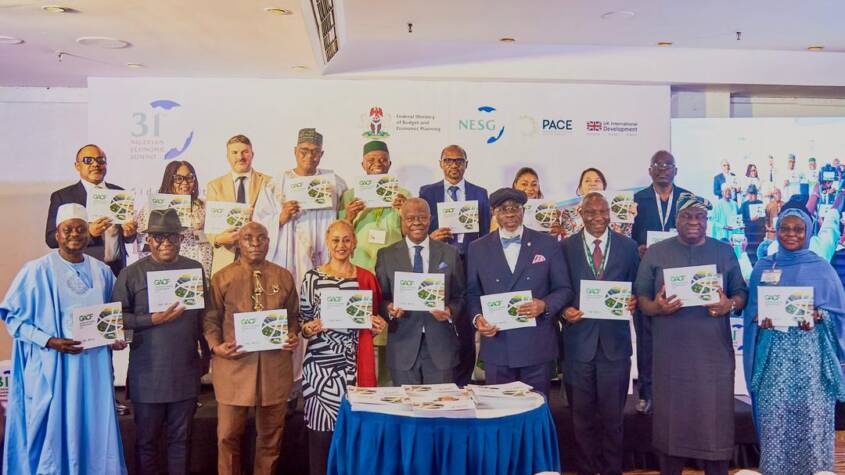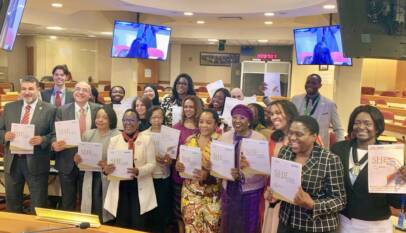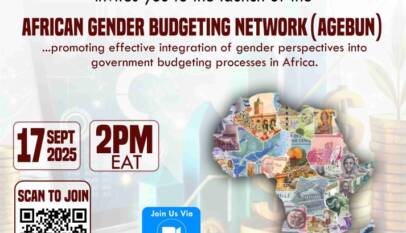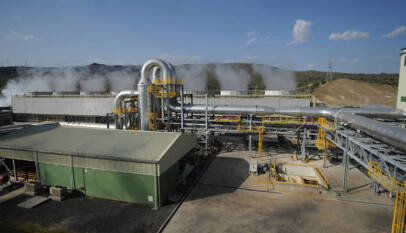EXPLAINER | Unpacking PACE Climate Finance Access Guide: Nigeria’s Roadmap to Green Growth
The newly launched PACE Climate Finance Access Guide provides a practical framework for state governments and businesses to navigate complex global climate funding mechanisms and translate climate ambitions into bankable and impact-driven projects.
Developed through a partnership between the UK Government’s Partnership for Agile Governance and Climate Engagement (PACE) programme and Nigeria’s Federal Ministry of Budget and Economic Planning (MBEP), the Guide reflects a shared commitment to advancing climate-responsive and sustainable growth.
The PACE Guide is designed to help state governments, private investors, and climate-smart enterprises navigate global climate finance, translate commitments into bankable projects and unlock funding for renewable energy, climate-resilient infrastructure, and adaptation initiatives nationwide.
Nigeria requires US$17.7 – US$27.2 billion annually through 2030 to meet its climate commitments under the Paris Agreement and its Nationally Determined Contributions (NDCs). Yet, the country loses over US$100 billion each year in economic value due to the combined effects of flooding, drought, desertification, and other climate-related disasters—losses that erode public revenue, threaten livelihoods, and slow economic growth.
These costs, detailed in Nigeria’s Climate Change Policy and Response Strategy and supported by analyses from the World Bank and the African Development Bank (AfDB), reflect the widespread damage to infrastructure, agriculture, and productivity caused by climate shocks.
Compounding this challenge are institutional weaknesses, limited capacity to design bankable projects, and investor concerns over policy and fiduciary risks—factors that have constrained Nigeria’s ability to access global climate finance.
In this EXPLAINER, we explore how the PACE Climate Finance Access Guide serves as both a roadmap and a reform instrument for Nigeria, bridging the gap between climate commitments and the financing needed to turn them into actionable results.
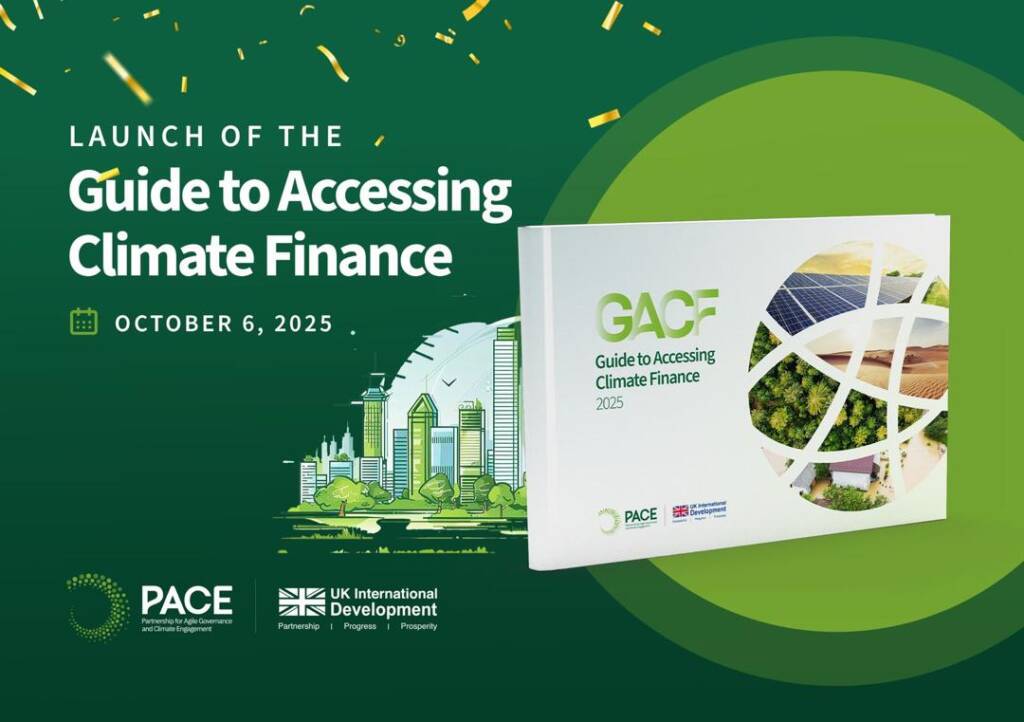
What PACE Guide Offers
Ifeanyi Ugwuoke, National Team Lead of PACE believes: “Nothing happens if you don’t have finance. Finance must be accessible to enable both governments and eco-friendly businesses to invest in critical infrastructure and adaptation initiatives.”
The Guide is both diagnostic and operational. It helps state governments, private investors, and green enterprises understand:
- Where climate funds exist
- How to meet eligibility requirements
- How to assess readiness and improve climate governance systems
- How to design bankable projects and monitor results
Thus, it identifies 93 potential climate finance sources, narrows them down to 33 viable options, and provides detailed guidance on 18 priority funding opportunities most accessible to Nigerian state governments and eco-friendly businesses. These are grouped into three main categories:
1. Domestic Sources
- Federation Account and Internally Generated Revenue (IGR)
- National Climate Change Fund (NCF)
- Ecological Fund
- Rural Electrification Fund
- Green bond facilities (e.g., FCMB Renewable Energy, Fidelity Bank Green Finance, Sterling One Foundation).
2. International and Multilateral Funds
- Green Climate Fund (GCF) – over US$20 billion pledged globally, supporting mitigation and adaptation projects.
- Global Environment Facility (GEF) – focuses on biodiversity, land degradation, and climate resilience.
- AfDB’s Africa Climate Change Fund (ACCF) – offers readiness grants and project preparation support.
- Others are UK International Climate Fund (ICF), AFD-GCF Credit and Tech Assistance Facility, Danish Climate Investment Fund, and Canada–AfDB Climate Fund.
- 3. Climate Financial Instruments
- Green Bonds for low-carbon infrastructure
- African Carbon Markets Initiative (ACMI)
- Debt-for-Climate Swaps and Payment for Environmental Services (PES).
“While billions are available globally for climate action, access requires meeting strict technical, governance, and fiduciary standards. The keyword is readiness,” said Ugwuoke. “This guide helps states and businesses understand and meet those standards.”
Climate Finance Readiness Assessment Checklist
At the heart of the PACE Guide is the Climate Finance Readiness Assessment Checklist—a diagnostic tool that allows states and businesses to evaluate their institutional and financial preparedness for accessing climate funds. The checklist assesses capacity across six pillars:
- Stakeholder Engagement: Inclusion of women, youth, the differently-abled, among other marginalized groups in planning and decision-making.
- Climate Governance: Existence of a climate change policy, legal framework, and institutional leadership (e.g., Climate Change Units).
- Planning & Budgeting: Integration of climate priorities into State Development Plans (SDPs), Medium-Term Expenditure Frameworks (MTEFs), and Medium-Term Sector Strategies (MTSSs).
- Investment Management: Systems for project appraisal, procurement, and monitoring.
- Revenue & Debt Management: Fiscal transparency and ability to manage grants, loans, and co-financing mechanisms.
- Public Financial Management (PFM): Compliance with the International Public Sector Accounting Standards (IPSAS), budget implementation, and reporting standards.
The Climate Finance Readiness Checklist enables users—whether at federal, state, or institutional levels—to assess their existing systems, identify gaps, and design reform plans before seeking funding. It is complemented by standardized reporting templates and readiness toolkits, available through PACE’s online platform, which provide step-by-step guidance on improving transparency, fiduciary systems, and project preparation capacity.
Who Can Use the Guide?
The Guide is tailored for:
- Federal and state governments, especially ministries and agencies responsible for climate action, infrastructure, and economic planning.
- Private investors and MSMEs seeking to invest in renewable energy, sustainable agriculture, and resilient infrastructure.
- Development Finance Institutions (DFIs) and NGOs implementing climate adaptation and mitigation projects.
Rolling Out Guide and Expected Impact?
The PACE programme will collaborate with the Nigeria Governors’ Forum (NGF) and the National Economic Council (NEC) to strengthen state-level capacity and integrate the Climate Finance Access Guide into existing public investment frameworks.
The rollout will feature training sessions, policy dialogues, and tailored technical assistance aimed at equipping state governments and green enterprises to design high-quality, investment-ready proposals capable of attracting both domestic and international climate finance.
By institutionalizing climate finance readiness, the Guide is expected to:
- Strengthen Nigeria’s ability to mobilize green capital for projects in energy, agriculture, and infrastructure.
- Create green jobs and promote inclusive economic growth.
- Enhance fiscal resilience by reducing losses from climate shocks.
- Position Nigeria as a regional leader in climate finance governance.
Strengthening States’ Fiscal Readiness
According to Chinedu Eze, PACE’s Green PFM Advisor, climate financing is not only about environmental protection but also fiscal innovation. “Given Nigeria’s limited fiscal space, unlocking additional climate-related resources is essential for bringing in new resources to fund state budgets and support eco-friendly enterprises.”
Thus, the Guide recommends targeted reforms to strengthen green Public Financial Management (PFM), particularly by improving budgeting processes, expenditure tracking, and revenue management. They include:
- Integrating climate funding into budget call circulars and MTEFs
- Allocating a share of capital budgets to climate-responsive expenditures
- Establishing contingency funds for climate emergencies
- Ensuring consistency between budget documents, debt reports, and financial statements
- Conducting performance audits and Public Expenditure and Financial Accountability (PEFA) assessments
Making Climate Finance Inclusive, Transparent
For Titilope Fakoya, Deputy National Team Lead of PACE, inclusivity and gender balance are non-negotiable in climate financing. “Climate finance must be inclusive. Women and men experience climate impacts differently. We can’t afford to design one-size-fits-all policies.”
In this vein, the PACE Guide is very inclusive, urging governments to consider how climate risks disproportionately affect women, youth, and marginalized groups. It also promotes participatory planning and gender-responsive budgeting, ensuring that climate investments translate into equitable opportunities for all.
A defining feature of the PACE Guide is its emphasis on transparency and accountability. Hence, states are urged to conduct performance audits, align with IPSAS reporting, and maintain public disclosure of climate finance flows.
“Accountability is key. Ten years ago, awareness was low. Now, there’s growing understanding that transparency drives access to funding,” noted Fakoya.
State Governments: From Awareness to Action
The Guide encourages states to move from fragmented, reactive approaches to coordinated and results-oriented systems. To do so, it outlines a five-step process:
- Conduct Baseline Readiness Assessments: Measure institutional gaps at the state and business levels using the checklist.
- Engage in Policy Dialogue & Technical Assistance: Partner with ministries and development partners to strengthen systems.
- Integrate Climate Finance into Planning Instruments: Integrate into SDPs, MTEFs, and MTSSs for budget predictability.
- Mobilise Private Sector Investment: Create incentives, clarify regulations, and build PPP pipelines.
- Monitor, Evaluate & Report: Track funding flows, outcomes, and climate impact indicators.
The PACE Guide seeks to position Nigerian state governments as credible actors capable of attracting both grants and concessional finance.
Conclusion: From Ambition to Results
Nigeria’s climate challenge is as much about governance as it is about finance. Thus, the PACE Climate Finance Access Guide bridges that divide — translating global commitments into actionable, bankable opportunities for states and the private sector.
By equipping stakeholders with tools to assess readiness, identify funding pathways, and implement robust reforms, the PACE Guide seeks to transform climate finance from an abstract ambition into tangible results for sustainable development.
As Ugwuoke concluded, “The opportunity is immense. To seize it, Nigeria must act with strategy, collaboration, and urgency!”
The PACE Climate Finance Access Guide stands as more than a policy document—it is a practical framework for translating ambition into action, enabling Nigeria to move from climate pledges to tangible implementation. If effectively deployed, the Guide could ensure that climate investments go beyond mitigating risks—improving lives, protecting livelihoods, and anchoring Nigeria’s transition toward a resilient, inclusive, and sustainable future.

